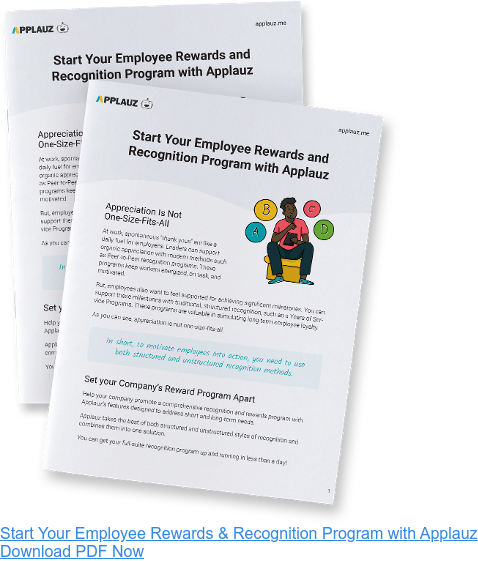A lot has changed since the early days of the pandemic in the Spring of 2020. As the pandemic dragged on throughout 2021, it seemed as though everyone’s collective morale took a major hit.
Employees in virtually every industry experienced spiked levels of anxiety, stress and burnout. And mental health disorders such as depression have hit a record high. Recent studies suggest that 1 in 3 Americans suffers from depression.
Workplace reports indicate that employee stress and burnout are still problems.
- 79% of leaders have seen a loss of productivity as a result of employee burnout (Leadershipiq, 2021)
- 57% of U.S. and Canadian workers reported feeling stress daily. (Gallup, 2021)
- Only 36% of employees say they are engaged at work. 15% are actively disengaged. (Gallup, 2021)
- Employees report being less engaged in 2021, and more people are reporting being “extremely burnt out” or “burnt out” at work. (Headspace, 2021)
It's clear — The pandemic had an irreversible impact on work.
In turn, we are witnessing an evolution of norms and expectations. Many brave companies stepped up to champion change.
But one thing remains constant: the importance of employee appreciation and recognition.
In fact, the top factor employees cited as reasons for quitting was that they didn’t feel valued by their organizations - (Mckinsey, 2021)
In 2022, it will be essential to prioritize systems that shine a light on employee effort and contributions. Our recent guide on building employee recognition and rewards strategies can assist you with your planning process if recognition is already high on your priority list.
That said, we believe employee appreciation is not just a 2022 (and beyond) matter but a timeless one. But, sadly, many companies don't meet this basic need. From their perspective, the only "recognition" that employees need is a regular paycheck.
This couldn't be farther from the truth. Everyone desires to feel esteemed and valued by their managers, peers, and organizational leaders. In short, appreciation is a basic human need.
With that in mind, let's look at the expected benefits of recognition in a little more detail.
 Treat the Root of the Issue, Not the Symptoms
Treat the Root of the Issue, Not the Symptoms
Employee disengagement is a costly issue for businesses. It's important to remember the first step to correctly treating a problem is knowing its root cause. Treating only the symptoms will never cure the underlying problem.
Regrettably, companies often don't survey their staff; in other words, they don't attempt to investigate problems that lie underneath. Surface-level solutions quickly follow.
These band-aid solutions seldom stick in the long term.
From an HR perspective, the symptoms of the problem — burnt out or disengaged employees — feel challenging to overcome. Understandably so. Issues like these are mired in difficult feelings.
But, before you jump to fix-it mode, take a step back.
With some distance and curiosity, you'll notice that beneath the feelings of detachment and frustration lies basic human needs that are going unfulfilled — to be respected, appreciated, and heard.
Lack of appreciation: a common cause of employee disengagement
To be clear, lack of feeling valued and appreciated is not the only source of disengagement, but it's profoundly common.
When people don't feel appreciated, respected, or heard, they feel frustrated and resentful. This universal truth transcends contexts, industry, age, culture, and gender.
In essence, when we give and give (without getting much in return), our mental and emotional gas tank drains.
Employees everywhere experience disengagement from a lack of appreciation. And the consequences of disengagement are costly for businesses.
- The top factor employees cited as reasons for quitting was that they didn’t feel valued by their organizations (54 percent). (Mckinsey, 2021)
- A lack of recognition remains one of the most common reasons why employees leave an organization. And further research suggests that the more talented the employee is, the faster they leave. (Gallup, 2017)
- Employees who do not feel adequately recognized are twice as likely to say they'll quit in the next year. (Gallup, 2016)
- 66% of employees say they would "likely leave their job if they didn't feel appreciated.” (Office Team, 2017)
- 37% of employees said their most desired area of company improvement was recognition. (Software Advice, 2020)
On the flip side, a culture defined by affiliation and security enables employees to flourish and do their best work.
That's because appreciation drives connection. And connection replenishes our mental gas tanks. In short, these small moments of connection build safety and trust over time.
That said, giving back to workers with sincere appreciation and recognition is a powerful way to start treating the problem's root. A growing body of research confirms a clear relationship between high levels of appreciation and employee engagement.
- Expressions of gratitude lead workers to feel valued and see where their actions impact the big picture. This compels workers to be helpful, supportive of others, and go the extra mile for their organization. (Academy of Management, 2016)
- Employees are especially grateful for organizations that care for their well-being and value their contributions. (APA PsychNet, 2018)
- A simple expression of thanks by someone in authority led people to be 50% more productive. (Journal of Personality & Social Psychology, 2010)
- 73% believed that recognition and rewards motivate their work ethic and productivity. And 64% of employees felt recognition and appreciation were even more important while working from home. (Snappy, 2020)
- After company-wide participation in a daily gratitude ritual for only two weeks, employees self-reported a noticeable reduction in rude, gossipy, and ostracizing behaviours among their coworkers. (Journal of Applied Psychology, 2020)
- 93% of employees say they’re more likely to stay with an empathetic employer. (Businessolver, 2020)
Fitting Appreciation into Your HR Strategy is Easy
At this point, I'm sure you don't even need to see these statistics to trust in the power of appreciation. We believe it on a gut level based on our own experience.
Your company probably practices some form of recognition already. For example, celebrating employee birthdays, work anniversaries or giving performance reviews each year.
Structured forms of recognition (like in the examples above) are a good starting point. But there are two major disadvantages to this type of recognition: they lack frequency and personalization.
To keep their mental gas tanks full, employees need genuine and personalized recognition more regularly – especially from their managers!
That's where Peer-to-Peer recognition comes in to fill the gaps and help grow appreciation in the workplace.
The beauty of this type of program is that it's easy to put in place. And unlike other initiatives in your HR Strategy that can take weeks to roll out, and many months before you see an impact, a digital recognition program can be up and ready in less than a day. And the positive feelings start flowing as soon as the first recognition message is sent!
Changing mindsets with a recognition program
Now, you're probably asking yourself — will employees even use the program?
We hear your concern. It's an important question!
And you're right — the main challenge for recognition often lies in opening employees up to the idea of expressing appreciation and gratitude openly in the workplace.
Without a doubt, expressing recognition is a soft-skill some people need help with!
The roll-out of an official program will help open employees up to the idea of expressing appreciation. This happens in two ways.
First, the roll-out of an official program puts recognition-giving at the forefront of everyone's minds. Remember, the positive feelings that spark as a result of recognition are contagious. In short, positive interactions have a way of snowballing and quickly inspiring everyone, even the biggest skeptics. New organizational habits will form in no time.
Second, an official program gives employees a “safe space” to express appreciation. It will never feel uncomfortable, forced, or awkward. Employees will be giving recognition on a platform (like social media) that is solely dedicated to recognition.
Think about it like this: A recognition program is akin to preparing a workout program before going to the gym.
Without an action plan, you would be lost and aimless at the gym, especially if you haven't exercised in years. A workout program is an essential tool to give you direction and keep you on track towards your fitness goals.
Similarly, a recognition program is essential because it sets the parameters appreciation-shy employees need. As such, it helps them stay motivated and on track towards healthier relational habits.

 Don’t Wait to Actively Support Employee Wellbeing
Don’t Wait to Actively Support Employee Wellbeing
A short time ago, many company leaders couldn't imagine allowing their employees to work from home. Despite having the technology and many compelling reasons, such as saving on office space, companies were reluctant to change.
Why?
There were too many unknowns. Understandably. The concept of remote work felt foreign and unconventional. In short, it went against traditional ideas about what "normal" workplaces look like.
In a similar vein, expressing recognition and gratitude at work may challenge the norms of your workplace or industry.
Except here, there are no unknowns.
Recognition is not another fleeting HR trend. The value of appreciation is timeless. Recognition will always be essential to employee engagement.
Data also proves the high ROI for businesses that focus on recognition. And not to mention the personal stories that demonstrate the power of gratitude.
Ultimately, the only thing preventing your company from growing a thriving culture of appreciation is a belief about the workplace.
Change can be tough. But remember, once the first leap is made, people are more adaptable than we give them credit for.
And if the pandemic has taught us anything, it's that some of our deepest held beliefs about work are untrue; and just how quickly people can adjust to a new normal when they are thrust into change.
Don't wait until your turnover rate is uncontrollable or employee burnout is a major issue to take action. The longer you wait, the more difficult it will be to resolve. Take action now, and treat the root of the problem. Put a recognition program at the top of your HR priorities for 2022.
About the author
 Michelle Cadieux
Michelle Cadieux
Michelle is a content writer for Applauz. She holds a Bachelor's degree in Psychology from Concordia University, and she has been writing about work and employee happiness for over five years.



